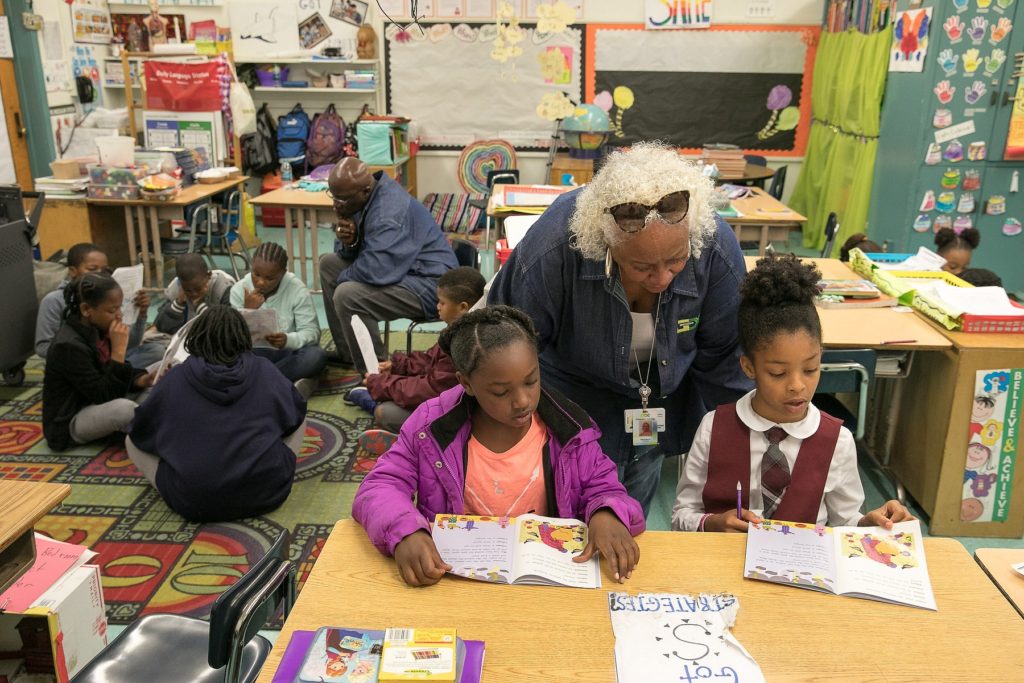Grant Spotlight: Generation Xchange
May 18, 2018
In a classroom at 54th Street School in the Windsor Hills neighborhood of Los Angeles, the laughter of 13 women matches the exuberant sounds of recess just outside.
These women are taking advantage of the classroom downtime to meet and discuss the successes and challenges they face. But they’re not teachers—they’re volunteers.
Generation Xchange, or GenX, was established by UCLA professor Teresa Seeman after collaborating on a similar program in Baltimore that brings middle-age and older adults into classrooms providing academic support.
“It’s designed to benefit both generations,” says Dr. Seeman. “The idea is to leverage the energy and skills of adults who may have time available, to work with kids who may need a little extra attention to gain the skills they need to succeed in the long term. It’s doing something that clearly is very important, and the participants feel like they’re doing something important at a time in their life when they’re ready to give back.”
Mr. Thompson was principal of Angeles Mesa Elementary in 2014 when Dr. Seeman and her partners at the Los Angeles Urban League approached him to start GenX at his school. It was an immediate success, and the program quickly spread to three additional schools, including 54th Street School where Mr. Thompson moved a few years later.
Initial support of the Los Angeles Urban League was essential to establishing relationships with local schools and recruiting the program’s first set of volunteers. Today, D’Ann Morris and Dawn Purnell, co-directors of GenX alongside Dr. Seeman, play a key role in the recruitment and retention of school relationships and program volunteers – “GenXers,” as they are commonly called.
The majority of GenXers at 54th Street School live in the area and learn about the program from local events or friends. “Recruiting is mostly word of mouth,” says Ms. Morris. “A one on one approach really works because people will buy into your passion.”
The local approach is potent because it prompts a sense of duty and purpose from the volunteers toward the next generation in their community.
“One of the original GenX volunteers is in a group I’m a part of. She came and did a presentation, and when I found that 54th street was involved, I knew I had to do it since I live six blocks away,” says GenXer Alyce Breaux.
“When I moved to this community my kids were already in school, so I never thought about having my kids come here,” says Helena Williams, a Lead GenX Volunteer at the school. “But after D’Ann twisted my arm, I realized that I’m as responsible as Mr. Thompson is for making this school successful because I live here. Just because my children didn’t go here doesn’t mean my responsibility is any different.”
Ms. Williams can clearly see her effect on the children she serves. “I’ve seen tremendous academic growth in the students, but also in their behavior.” As a GenXer, she can pull aside students having trouble and work with them one-on-one. One student in particular was getting agitated when he didn’t understand the material and would act out, distracting the other students. But as Ms. Williams worked with him, he was able to catch up and participate more fully in the classroom.
Because GenXers commit to 10 hours a week in the classroom, their consistent presence is a boon to new and experienced teachers alike—making them an additional group benefiting from the program.
“Miss Alyce is priceless,” says Judith Cawthorne, a longtime first grade teacher at 54th Street School, of her GenX volunteer. “On the days she’s here, it makes a big difference. This is my second year with her, so she knows my routine. She comes in and it’s seamless.”
Mr. Thompson says the effect is profound on new teachers as well. “Having that support in the classroom helps with new teacher retention and success,” he says. “We’ve had a couple new teachers come in who probably would not have made it or had such growth without the additional support in the classroom.”
As the program grows, Dr. Seeman is tracking the measurable benefits each generation sees through the program. While testing data analysis for the students is not yet complete, anecdotal evidence shows improvement for academic and behavioral issues. For the GenXers, the demonstrated health benefits are impressive. “They’re physically active, it’s very social, and it’s cognitively stimulating,” she says. “People are losing weight, their blood pressure is down, the levels of inflammation are down, they’re walking faster.”
“It’s good to see that not only the kids benefit, but the adults do too,” says Mr. Thompson. “The GenX ladies really feel and know that they’re needed and wanted. They know they’re doing something important.”
Learn more about Generation Xchange here.
